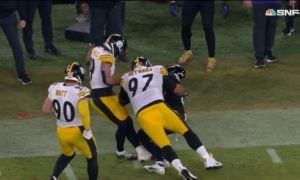Wide receiver Mike Wallace is long gone and gone with him is the 67 explosive plays of 20 yards or more that he accumulated during his four seasons with the Pittsburgh Steelers. In an effort to fill the void that was created when Wallace signed with the Miami Dolphins early in the free agent signing period, the Steelers drafted Oregon State wide receiver Markus Wheaton in the third round of the 2013 NFL Draft.
While Wheaton certainly demonstrated his ability to produce explosive plays in college, 18 catches for 20 yards or more in 2012, it might take him a little while to see extensive playing time due to the fact that he is behind heading into training camp after missing all of the OTA sessions and the mandatory mini camp due to graduation rules. Until he is ready to contribute on a regular basis, it will be up to Antonio Brown and Emmanuel Sanders to produce the receiving explosive plays with Wallace now gone.
In the new offense instituted last season by offensive coordinator Todd Haley; the Steelers only produced 49 receiving explosive plays. The three years prior to that, the offense generated 60, 62 and 77 explosive receiving plays with Bruce Arians orchestrating the offense.
Keep in mind that in 2012 tight end Heath Miller was responsible for 11 of the 49 receiving explosive plays himself, which was a career high for him. With his status for the start of the 2013 season still uncertain as he continues to recover from his serious knee injury suffered late last season, that could potentially be more of a void to fill when it comes to explosive receiving plays. Both Brown and Sanders were responsible for 21 of the 49 last year, so expecting them to produce much more than that in 2013 will be asking quite a bit. In addition, both Plaxico Burress and Jerricho Cotchery are up in age, and neither should be expected to produce many plays of 20 yards or more, so you can definitely see the problem here.
So just how important are explosive plays? If you followed my TOX Stat tracking the last few years, you should know by now that a team wins 80% of the time when they have two or more explosive plays than their opponent does in a game. Now, does this mean that the Steelers can\’t win games, assuming their receiving explosive play count could take a hit in 2013, especially early in the season? No, and Haley proved this in 2010 himself as the head coach of the Kansas City Chiefs. That season his offense only produced 40 receiving explosive plays the entire season yet the team went 10-6 and made the playoffs.
So how did Haley offset the lack of receiving explosive plays produced by the offense? He did it with the running game of course, as not only did the Chiefs offense lead the league in rushing yards per game that season (164.2), but they also finished fourth in the league in yards per carry (4.72). Not only that, but the running game also produced 15 explosive plays on the ground, which helped the team at least have a positive explosive play differential of one by the end of the regular season.
Now, being as the Steelers are coming off of a season that included them finishing 26th overall in rushing yards per game (96.1) and 28th overall in yards per carry (3.73), you can definitely see the challenge that awaits the rebuilt offensive line and rookie running back Le\’Veon Bell, along with Haley and new offensive line coach Jack Bicknell Jr.
The Steelers managed to go 8-8 last season thanks mostly to the play of quarterback Ben Roethlisberger prior to his injury taking place and the play of the defense, as the running game failed to produce. Due to the explosive play void created by the offseason loss of Wallace and the potential early-season absence of Miller, the team can expect to go 8-8 again in 2013 if the running game fails to produce for a second season in a row.







